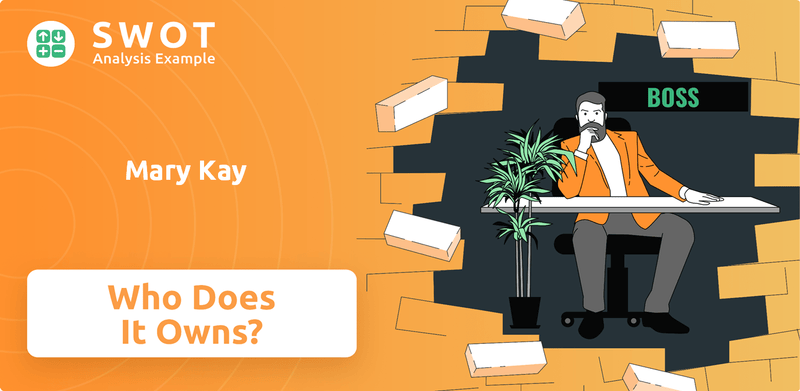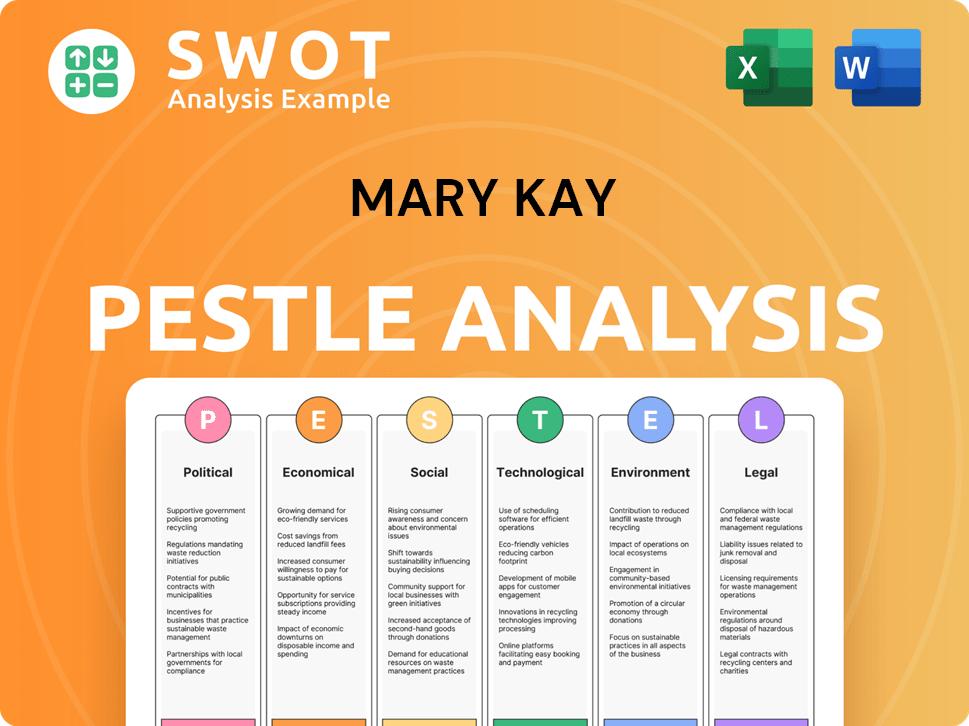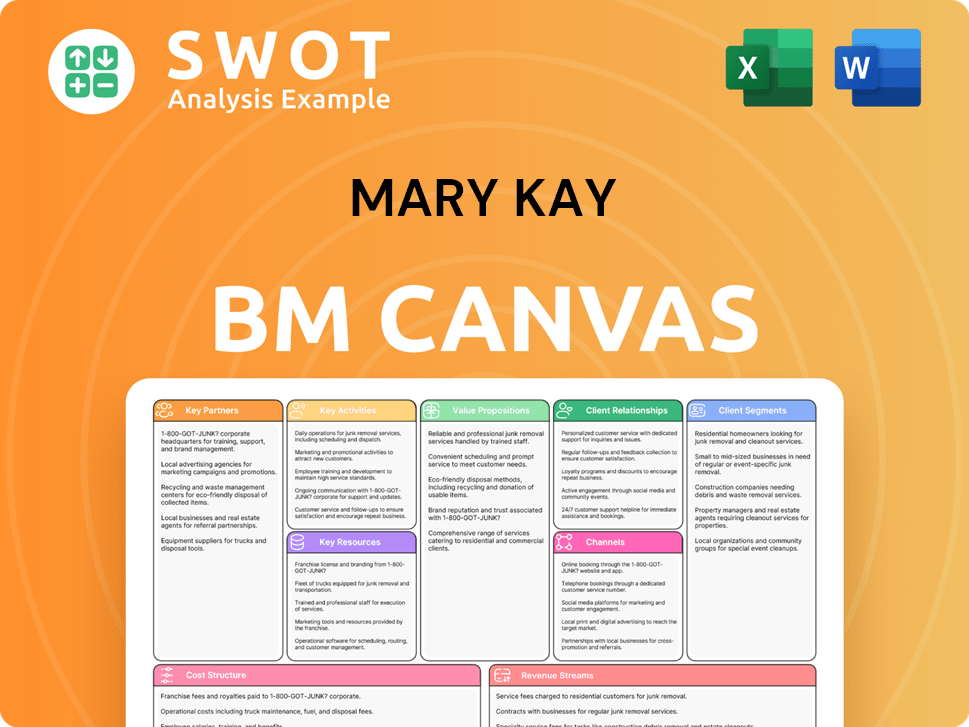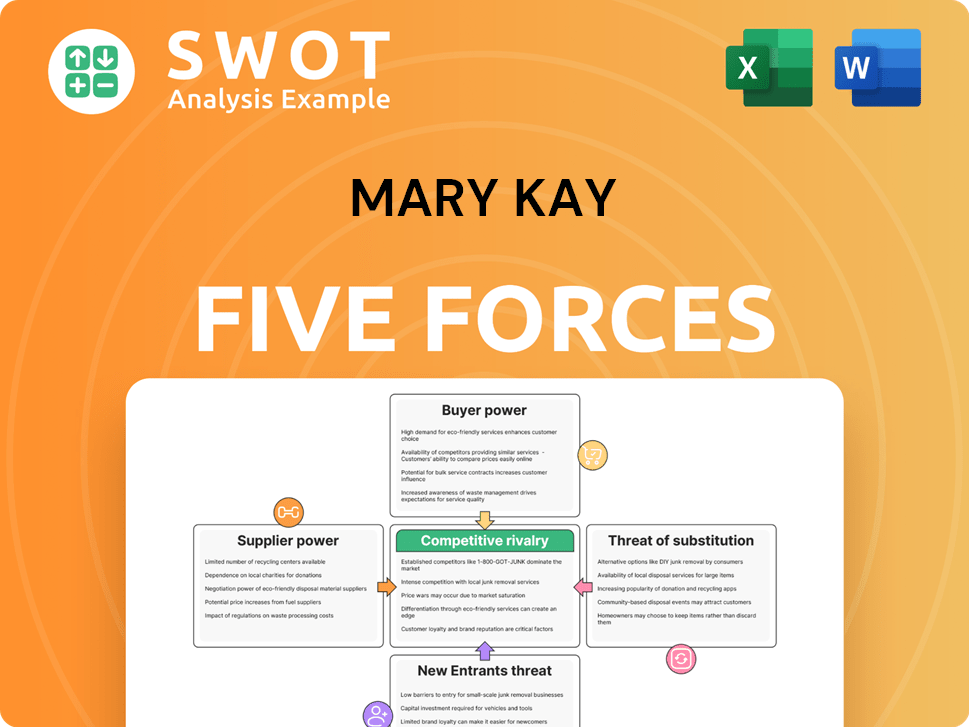Mary Kay Bundle
Who Really Owns Mary Kay?
Uncover the ownership secrets behind one of the world's leading direct sellers of beauty products. Founded in 1963 by Mary Kay Ash, the Mary Kay SWOT Analysis reveals a company with a unique business model. Understanding the Mary Kay ownership structure is key to grasping its strategic direction and market influence. What are the forces that have shaped this iconic beauty brand?

Delving into the Mary Kay company's ownership is crucial for anyone seeking to understand its operations, strategic direction, and long-term prospects. The Mary Kay founder's vision has evolved into a global enterprise, making the question of who owns Mary Kay Inc. a compelling one for investors, consultants, and industry observers. This exploration will uncover the key players and pivotal moments that have shaped the company's structure, providing valuable insights into this privately held giant's trajectory and future.
Who Founded Mary Kay?
The Mary Kay company was established in 1963 by Mary Kay Ash, a pivotal figure in the direct selling industry. Her vision was to create a business that would offer women opportunities for financial independence and personal growth. With the support of her son, Richard Rogers, and her husband, Mel Ash, she launched what would become a global beauty empire.
The initial investment to start Mary Kay Inc. was $5,000, a sum Mary Kay Ash had saved. This seed money was crucial in setting the foundation for the company's operations. While the exact equity distribution at the beginning isn't publicly detailed, Mary Kay Ash held the primary ownership and control, reflecting her central role in shaping the company's mission and values.
The early ownership structure of Mary Kay was primarily family-based. This approach allowed Mary Kay Ash to maintain control over the business model and ensure that the company's core principles remained intact. Richard Rogers played a significant role in the company's operational framework and eventually took on leadership responsibilities, continuing his mother's legacy.
The early days of Mary Kay saw a closely-held ownership structure within the family. This was essential for maintaining the company's unique business model and its focus on empowering women. The absence of external investors allowed for a strong emphasis on the independent beauty consultant network, which was key to the company's early success.
- Mary Kay Ash held primary ownership and control.
- Richard Rogers played a crucial role in operations and leadership.
- The company was initially bootstrapped with a $5,000 investment.
- The family's involvement ensured the founding vision was deeply embedded.
Mary Kay SWOT Analysis
- Complete SWOT Breakdown
- Fully Customizable
- Editable in Excel & Word
- Professional Formatting
- Investor-Ready Format

How Has Mary Kay’s Ownership Changed Over Time?
The Growth Strategy of Mary Kay has been significantly shaped by its ownership structure. The Mary Kay company has largely remained a privately held entity. This status has allowed it to focus on long-term strategies, free from the immediate pressures often faced by publicly traded companies. Key changes in its structure have typically involved internal transitions rather than public market events.
Following the passing of Mary Kay founder Mary Kay Ash in 2001, ownership and control primarily remained with her family. Richard Rogers, her son, served as Chairman Emeritus until his passing in 2022. This family ownership has been a constant, influencing the company's strategic direction and ensuring the continuation of Mary Kay Ash's founding principles. The Mary Kay ownership structure has remained stable, allowing the company to navigate market changes while maintaining its core identity.
| Aspect | Details | Impact |
|---|---|---|
| Ownership Type | Privately held | Long-term strategic focus, less pressure from quarterly reports |
| Primary Owners | Rogers family (descendants of Mary Kay Ash) | Preservation of founding principles, influence on strategic direction |
| Public Market Involvement | None (no IPO or public stock) | Freedom from public market volatility, ability to prioritize internal growth |
Currently, the ownership of Mary Kay Inc is predominantly held by the Rogers family. While specific percentages are not publicly disclosed, the family continues to be the principal owner. The company's governance and strategy are largely shaped by the family's vision and long-term commitment to the direct selling model. There are no external venture capital or private equity firms publicly identified as major stakeholders. This stable, private ownership has allowed Mary Kay to maintain its core identity and adapt to market changes. The company's revenue in recent years has been steady, reflecting the stability provided by its private ownership structure.
The company's private ownership structure allows for a long-term strategic focus.
- The Rogers family, descendants of Mary Kay Ash, are the primary owners.
- No public stock or external venture capital involvement.
- This structure supports the company's commitment to its founding principles and values.
- The private ownership has fostered stability and adaptability in a dynamic market.
Mary Kay PESTLE Analysis
- Covers All 6 PESTLE Categories
- No Research Needed – Save Hours of Work
- Built by Experts, Trusted by Consultants
- Instant Download, Ready to Use
- 100% Editable, Fully Customizable

Who Sits on Mary Kay’s Board?
The Board of Directors at the privately held Mary Kay Inc. primarily comprises individuals closely connected to the founding family and long-term executives. Due to its private status, a comprehensive public list of all board members and their affiliations isn't readily available. However, family members of Mary Kay founder Mary Kay Ash have historically held significant positions, reflecting their ownership stake and control. For example, Ryan Rogers, the founder's grandson, serves as the Chief Investment Officer and is a board member, showing ongoing family involvement in leadership and governance. David Holl, who previously served as Chairman and CEO, also held a crucial role on the board, representing executive leadership.
The board's function is to ensure the company's long-term success while upholding the founder's vision, with the family's voting power underpinning this governance. This structure allows for a more stable and unified decision-making environment compared to public companies. The Mary Kay company structure, therefore, is designed to maintain the founder's legacy and strategic direction.
| Board Member | Role | Family Affiliation |
|---|---|---|
| Ryan Rogers | Chief Investment Officer, Board Member | Grandson of Mary Kay Ash |
| David Holl | Former Chairman and CEO, Board Member | Executive Leadership |
| Other Board Members | Details Not Publicly Disclosed | Likely Family and Long-Term Executives |
The voting structure within a privately held company like Mary Kay typically links voting power directly to ownership stakes. The significant ownership held by the Rogers family translates into substantial voting power, allowing them to exert considerable control over strategic decisions and executive appointments. Unlike public companies, Mary Kay's business model and private ownership structure provide a more stable decision-making environment. You can learn more about the competitive environment in the Competitors Landscape of Mary Kay.
The Board of Directors is primarily composed of family members and long-term executives.
- Family ownership translates to significant voting power.
- This structure ensures the founder's vision is maintained.
- Private ownership offers a stable decision-making environment.
- The leadership team is closely tied to the company's history.
Mary Kay Business Model Canvas
- Complete 9-Block Business Model Canvas
- Effortlessly Communicate Your Business Strategy
- Investor-Ready BMC Format
- 100% Editable and Customizable
- Clear and Structured Layout

What Recent Changes Have Shaped Mary Kay’s Ownership Landscape?
In the past few years, the ownership structure of the Mary Kay company has remained largely unchanged. The company, formally known as Mary Kay Inc., continues to be primarily owned by the family of its founder, Mary Kay Ash. This stability reflects a strategic decision to maintain the company's core values and long-term vision, avoiding the pressures often associated with public markets. There have been no significant announcements regarding share buybacks, secondary offerings, or shifts in controlling ownership.
While the direct selling industry, which includes the Mary Kay business, has seen evolving consumer preferences and regulatory scrutiny, these factors have not significantly impacted the company's ownership. Leadership changes, such as the appointment of Nathan Moore as President of Global Sales and Marketing in 2023, have occurred within the existing ownership framework, indicating a consistent approach to the company's operations. The focus remains on global expansion and supporting independent beauty consultants.
The Mary Kay company has maintained its private ownership structure. The company's ownership remains primarily within the Ash family. This stability is a key characteristic of the company.
The direct selling industry faces evolving consumer preferences. Regulatory scrutiny is an indirect influence on operations. These trends have not changed the Mary Kay ownership structure.
Leadership changes have occurred within the existing framework. Nathan Moore was appointed President of Global Sales and Marketing in 2023. These changes do not signal a shift in control.
The focus remains on global expansion. The company is committed to supporting its independent beauty consultants. There are no current plans for changes to the ownership profile.
Mary Kay Porter's Five Forces Analysis
- Covers All 5 Competitive Forces in Detail
- Structured for Consultants, Students, and Founders
- 100% Editable in Microsoft Word & Excel
- Instant Digital Download – Use Immediately
- Compatible with Mac & PC – Fully Unlocked

Related Blogs
- What are Mission Vision & Core Values of Mary Kay Company?
- What is Competitive Landscape of Mary Kay Company?
- What is Growth Strategy and Future Prospects of Mary Kay Company?
- How Does Mary Kay Company Work?
- What is Sales and Marketing Strategy of Mary Kay Company?
- What is Brief History of Mary Kay Company?
- What is Customer Demographics and Target Market of Mary Kay Company?
Disclaimer
All information, articles, and product details provided on this website are for general informational and educational purposes only. We do not claim any ownership over, nor do we intend to infringe upon, any trademarks, copyrights, logos, brand names, or other intellectual property mentioned or depicted on this site. Such intellectual property remains the property of its respective owners, and any references here are made solely for identification or informational purposes, without implying any affiliation, endorsement, or partnership.
We make no representations or warranties, express or implied, regarding the accuracy, completeness, or suitability of any content or products presented. Nothing on this website should be construed as legal, tax, investment, financial, medical, or other professional advice. In addition, no part of this site—including articles or product references—constitutes a solicitation, recommendation, endorsement, advertisement, or offer to buy or sell any securities, franchises, or other financial instruments, particularly in jurisdictions where such activity would be unlawful.
All content is of a general nature and may not address the specific circumstances of any individual or entity. It is not a substitute for professional advice or services. Any actions you take based on the information provided here are strictly at your own risk. You accept full responsibility for any decisions or outcomes arising from your use of this website and agree to release us from any liability in connection with your use of, or reliance upon, the content or products found herein.